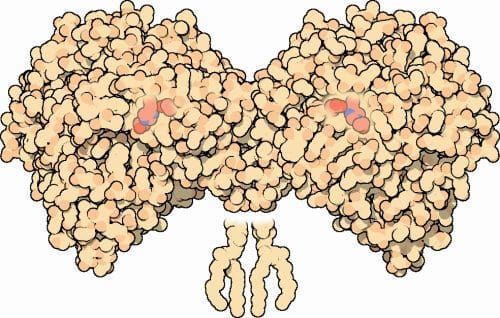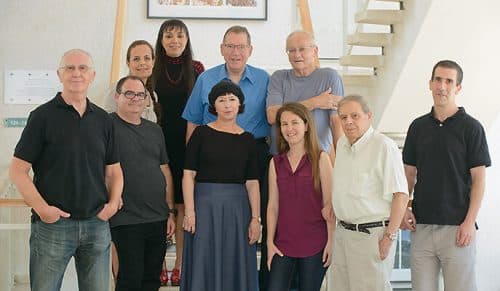Scientists from the Weizmann Institute have created a new method for stabilizing proteins, based on a preliminary calculation of physical properties, finding the stable protein sequence, and engineering the desired protein.

Stability is an important quality in life, and in quite a few cases, also in the life sciences. A striking example in this regard can be the proteins, which carry out most of the life processes in the cell. The study of these proteins has often encountered difficulty, since many proteins, and especially large proteins that are present and work in the cells of the human body, are unstable. They are very difficult to produce in bacterial systems, they are also sensitive to heat or environmental conditions, and others simply have an extremely short lifespan.
in research recently published in the scientific journal Molecular cells Offer Dr. Sheral Fleishman and his research student, Adi Goldenzweig, as well as Prof. Dan Toufik and staff scientist Dr. Moshe Goldschmid, from the Department of Biomolecular Sciences at the Weizmann Institute of Science, a way to solve this difficulty. As part of her doctoral research, Goldenzweig developed a method for stabilizing proteins, based on the calculation of physical properties, on the one hand, and on databases of molecular structures that have been built in recent years, on the other hand. As part of her research, she tried to create a stable version of the enzyme acetylcholine esterase or AChE (see box). This is a rather brave choice, since not only is this enzyme sensitive to heat, and temperature changes may impair its function, but it is also active in the brain and at the communication junctions between nerves and muscles, and plays a central role in two different areas - Alzheimer's disease and the modes of action of nerve gases and pesticides. A stable version of the enzyme may allow for a variety of applications in both research and medicine.
Goldenzweig wrote algorithms for designing proteins, and after examining together with Dr. Fleishman the possible designs of acetylcholine esterase, they predicted that the stable version of the enzyme would include 51 different mutations - about 10% of the amino acids in the active segment of the enzyme. Applying such a quantity of changes to one protein molecule is a difficult and complex process, and this is where staff scientist Dr. Moshe Goldshmid, from Prof. Toufik's laboratory, also from the Department of Biomolecular Sciences at the Institute, enters the picture. Dr. Goldschmid confirmed the prediction in an experiment, and showed that the protein that was produced according to the plan, and included all the proposed mutations, indeed stabilized significantly, and it was now possible to produce it in large quantities in bacterial systems, and it would function well at high temperatures.

Following the success of this experiment, the scientists - who were joined by staff scientist Dr. Haim Prilosky - set up an automatic server for predicting the changes necessary to stabilize proteins, which was named Protein Repair One Stop Shop (PROSS). "The server is open for use by scientists from all over the world," says Dr. Fleishman. "You feed a protein, and a few hours later you get several different predictions for stabilized versions of the protein, which are easy to test in the laboratory." The new stabilization method may help in the development of drugs based on proteins, in the production of proteins that will maintain stability even at high temperatures, in the storage of vaccines without refrigeration, or in the delivery of antibodies to places far from hospitals.
The story of an enzyme
In 1993, two scientists from the Weizmann Institute of Science, Prof. Israel Silman from the Department of Neurobiology and Prof. Yoel Sussman from the Department of Structural Biology, succeeded in deciphering the three-dimensional spatial structure of the enzyme acetylcholine esterase. This enzyme plays a central role in the nervous system: it breaks down the neurotransmitter acetylcholine, thus allowing the passage of additional signals at the junctions between nerves and muscles. When the enzyme is not active at the required level, and does not properly break down acetylcholine, an excess of acetylcholine is created at these junctions, and as a result, the nerve signals "lock" the muscles, which may cause respiratory arrest and death.
In fact, this is exactly what nerve gas and pesticides do: they inhibit the breaking down enzyme, thereby causing a harmful build-up of the neurotransmitter. But inhibiting the decomposing enzyme can also have positive effects, for example, in patients with Alzheimer's disease: inhibiting the decomposing enzyme, which strengthens neural communication, is actually a desirable process; Indeed, drugs for Alzheimer's disease are based on substances that inhibit the disintegrating enzyme.
About a decade after deciphering the three-dimensional spatial structure of acetylcholine esterase, Prof. Dan Toufik, from the Department of Biomolecular Sciences, tried to develop an efficient version of the enzyme, but the instability of the molecule did not allow this. That's why Prof. Toufik suggested to Dr. Sheral Fleishman to try to find a way to stabilize the protein. And so, more than 20 years after the achievement of Prof. Sussman and Prof. Silman, the current research by Adi Goldenzweig and Dr. Fleischman may help find better ways to inhibit this enzyme, thus serving as a basis for advanced treatment of Alzheimer's disease.
Science books
The enzyme acetylcholine esterase consists of 550 amino acids. The number of possible sequences for a protein of this size is 10715 – more than the number of atoms in the universe. To significantly reduce this number, and to find the solutions with the best chances of functioning stably, a sophisticated and efficient algorithm is necessary. The algorithm developed by the scientists reduced the number of possibilities to 1030.
